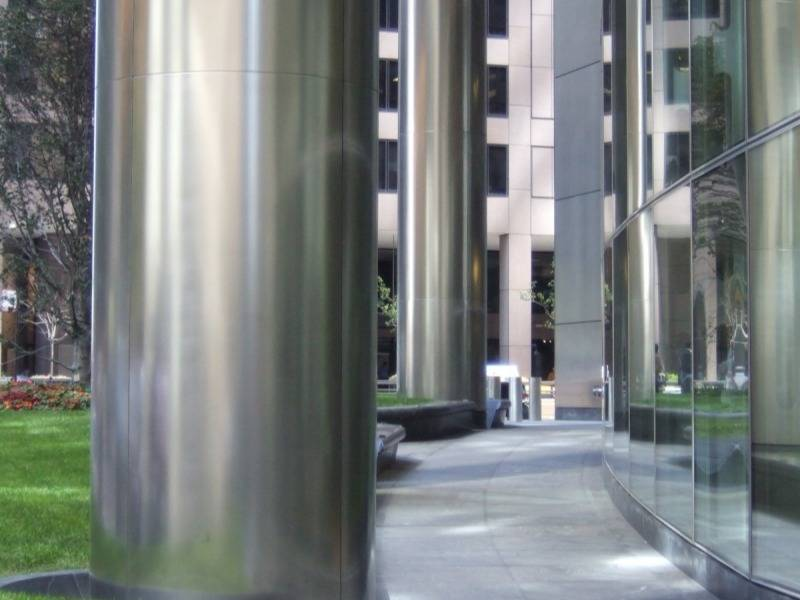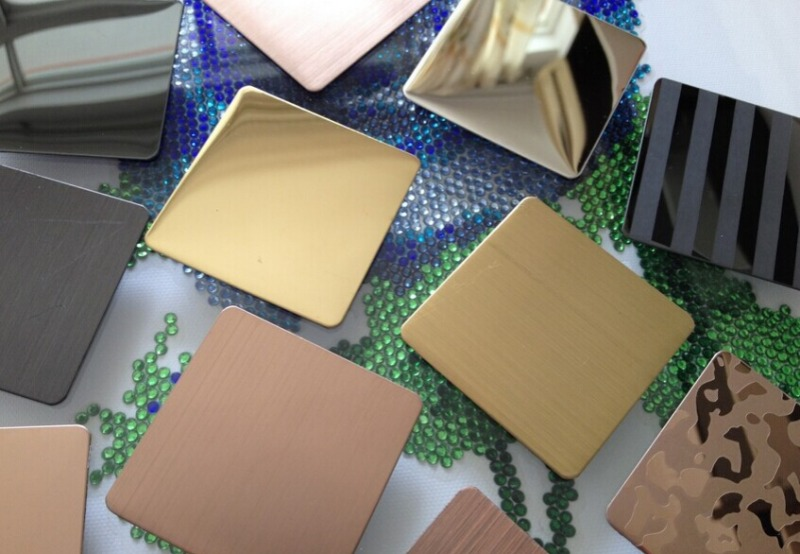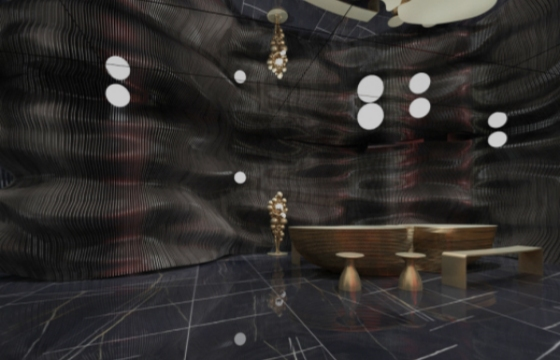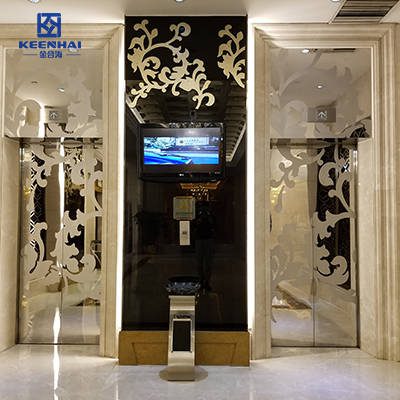PVD coating gives stainless steel a long-lasting, scratch-resistant finish that keeps surfaces shiny even in high-traffic areas. Unlike traditional stainless steel, it resists corrosion and fading, making it ideal for elevators, kitchens, and architectural panels. Hotels and commercial buildings benefit from reduced maintenance and extended material life, saving both time and money while maintaining a polished, professional look.
1.Material Composition and Manufacturing Process
1.1Understanding PVD Coating Technology
PVD, or Physical Vapor Deposition, creates an ultra-thin metallic layer on surfaces like Lim od nehrđajućeg čelika to enhance appearance and durability. This coating typically measures 0.5–3 microns thick, offering a high gloss finish that resists scratches and fingerprints. PVD coatings maintain their color for over 10 years, even in high-traffic hotel lobbies or humid coastal areas. The process involves 1. Preparing the stainless steel substrate, 2. Placing it in a vacuum chamber, 3. Vaporizing metal sources like titanium or chromium, 4. Depositing atoms onto the surface in a controlled environment. Hotels and commercial buildings benefit from PVD because it combines luxurious aesthetics with long-term resilience.
1.2How Traditional Stainless Steel is Produced
Traditional stainless steel starts as raw iron ore or scrap, melted at temperatures of 1400–1600°C, then cast into slabs. After hot rolling and annealing, the sheets achieve thicknesses from 0.3 mm to 3 mm, suitable for elevator doors, facade panels, and interior fixtures. For architectural applications, especially high-end hotels, Metalna ploča od nehrđajućeg čelika offers greater rigidity and dimensional stability compared with thinner sheets. Standard grades include 304 and 316, with 316 preferred in humid or saline environments because of its superior corrosion resistance up to 1,500 hours in salt spray tests.
1.3Key Structural Differences Between PVD Coated and Traditional Stainless Steel
The core distinction lies in surface performance and microstructure. PVD-coated sheets retain a base stainless steel substrate, ensuring mechanical strength while adding a protective and decorative layer. Traditional stainless steel relies solely on alloy composition, meaning scratch or fingerprint resistance depends on mechanical polishing or passive oxide layers. Below is a comparison for clarity:
| Značajka | PVD Coated Stainless Steel | Traditional Stainless Steel |
|---|---|---|
| Surface Finish | Custom colors, high gloss, scratch-resistant | Brushed, mirror, limited color options |
| Otpornost na koroziju | Excellent, additive layer protects from acid and salt | Moderate, depends on grade (304 vs 316) |
| Maintenance | Low, easy to clean with microfiber | Medium, frequent polishing required |
| Longevity in Lobbies | 10–15 years with minimal wear | 5–10 years, may show wear faster |
| trošak | 15–25% higher upfront | Lower upfront, higher maintenance costs |
1.4Real-World Applications and Considerations
Hotels in New York and Dubai frequently select PVD-coated stainless steel for elevator doors and wall panels because the finish combines elegance with resistance to fingerprints, even with thousands of daily guests. Traditional stainless steel, while durable, often shows minor scratches and dulling within 2–3 years in similar conditions. When specifying sheets for projects, architects evaluate thickness, grade, surface texture, and PVD finish type, ensuring visual continuity across elevators, doors, and decorative panels. For larger structures, pairing Nehrđajući čelični lim with PVD coatings maximizes both performance and aesthetic impact.
Selection Tips for Architects and Builders
-
Identify environmental factors — coastal, humid, or high-traffic areas demand corrosion-resistant coatings or 316-grade substrates.
-
Determine visual goals — PVD coatings provide a wider color spectrum and high gloss, while brushed stainless steel offers subtle elegance.
-
Calculate lifecycle costs — consider maintenance, replacement, and cleaning frequency when comparing PVD-coated sheets vs traditional stainless steel sheets.
-
Match thickness and size requirements — elevator doors typically require 1.0–1.5 mm sheets, while wall panels may need 2–3 mm plates for rigidity.
By combining PVD coatings with carefully chosen stainless steel grades, hotels and commercial projects achieve an optimal balance of luxury, durability, and cost-effectiveness. For more solutions on stainless steel applications, explore our full range of stainless steel products.

2.Surface Appearance and Aesthetic Value
2.1Color Options and Customization
PVD-coated Lim od nehrđajućeg čelika allows architects to achieve a wide spectrum of colors, including gold, bronze, black, and champagne, while traditional stainless steel relies mostly on brushed or mirror finishes. Color consistency across multiple panels reaches ±2 Delta E, ensuring elevator doors, wall panels, and ceiling trims look uniform even under different lighting. For custom hotel projects, the process involves:
-
Selecting base stainless steel grade (304 or 316 for high durability).
-
Choosing coating metal (titanium, chromium, or zirconium) depending on desired hue.
-
Fine-tuning thickness between 0.5–3 microns for durability and gloss.
-
Applying PVD coating in vacuum chambers, controlling deposition rate for uniform color.
Hotels in Dubai and Singapore often use PVD-coated elevator doors to match luxurious interiors, and designers report less than 5% color deviation after 5 years, even in humid or high-traffic environments.
2.2Gloss, Texture, and Design Flexibility
The surface texture of PVD stainless steel sheets can range from high gloss mirror to satin brushed finishes, providing designers with exceptional flexibility. Traditional stainless steel can achieve similar textures, but it requires mechanical polishing, which is labor-intensive and may leave micro-scratches. PVD coatings allow for embossed patterns, laser etching, and even gradient effects, enabling brands to reflect their identity on elevator doors, wall panels, and decorative trims.
| Značajka | PVD Coated Stainless Steel | Traditional Stainless Steel |
|---|---|---|
| Gloss Level | 80–95 GU (Gloss Units) | 40–80 GU |
| Texture Options | Brushed, matte, patterned, embossed | Brushed, mirror, basic polishing |
| Customization | Full color spectrum, laser etching | Limited, manual finishing required |
| Izdržljivost | 10–15 years high-traffic | 5–10 years, prone to micro-scratches |
2.3Long-Term Fade Resistance
PVD coatings offer exceptional UV and chemical resistance, keeping colors vibrant for over a decade even in sunlight-exposed lobbies. Traditional stainless steel may oxidize or slightly dull within 2–3 years, especially in coastal climates. Maintenance is straightforward: microfiber cleaning with neutral detergents 2–3 times per month suffices for most high-traffic elevators. In projects like hotel towers in Miami, PVD-coated Metalna ploča od nehrđajućeg čelika panels maintained full luster after 7 years of daily operation with over 1,000 guests per day.
Designers selecting materials for premium interiors should consider 1. Color longevity, 2. Texture adaptability, 3. Resistance to wear, 4. Ease of maintenance, i 5. Overall visual impact on guest experience. By combining PVD coatings with carefully chosen stainless steel substrates, hotels achieve both stunning visuals and long-term performance, enhancing brand perception while minimizing maintenance costs.

3.Performance and Durability Comparison
3.1Corrosion and Oxidation Resistance
PVD-coated Lim od nehrđajućeg čelika offers superior resistance to corrosion compared to traditional stainless steel, particularly in humid, coastal, or chemically aggressive environments. The PVD layer acts as a thin, hard barrier that prevents water, salt, and acidic compounds from reaching the metal surface, while 304 or 316 stainless steel without coating may start showing oxidation or pitting within 2–5 years under similar conditions. Hotels near oceanfronts, like in Miami and Singapore, use PVD-coated panels for elevator doors, wall cladding, and handrails, ensuring maintenance intervals extend by 30–50% compared to uncoated stainless steel.
3.2Scratch, Wear, and Impact Resistance
PVD coatings also dramatically enhance scratch and wear resistance. On a Mohs hardness scale, the coating can reach 5–7, compared to 3–4 for standard stainless steel, reducing visible damage in high-traffic areas. Traditional brushed stainless steel can accumulate micro-scratches from luggage carts, cleaning tools, or daily use, while PVD surfaces retain a pristine look much longer. Impact tests on hotel elevator doors demonstrate that even with 50–100 impacts per day over a decade, PVD-coated doors maintain integrity and visual appeal, whereas uncoated doors often require refinishing or replacement after 5–7 years.
| Značajka | PVD-Coated Stainless Steel | Traditional Stainless Steel |
|---|---|---|
| Otpornost na koroziju | Excellent, salt spray >1,000 hours | Moderate, salt spray 200–500 hours |
| Scratch Resistance | Mohs 5–7 | Mohs 3–4 |
| Wear Resistance | 10–15 years in high-traffic | 5–8 years in high-traffic |
| Impact Durability | High, no visible dents from 50–100 daily impacts | Moderate, dents visible after heavy use |
3.3Performance in Harsh Environments
Hotels located in extreme climates—deserts, coastal cities, or areas with heavy air pollution—benefit from PVD stainless steel due to resistance to temperature fluctuations, humidity, and chemical exposure. For example, Dubai’s high-rise hotels installed PVD-coated Stainless Steel Metal Plate for elevator doors and decorative wall panels; after 7 years of exposure to 45–50°C temperatures and salty desert air, the panels showed less than 2% color or texture degradation. Routine cleaning with neutral detergents and microfiber cloths keeps the surfaces gleaming without chemical stripping, saving up to 40% in maintenance costs over a decade.
Choosing PVD-coated materials over traditional stainless steel ensures long-lasting performance, minimized maintenance, and retained aesthetic appeal. Designers and facility managers can confidently invest in these materials for elevators, wall panels, and other high-touch surfaces in hotels and luxury buildings. For more options and related stainless steel solutions, explore our Stainless Steel Products page.

4.Maintenance and Lifecycle Costs
4.1Cleaning and Upkeep Requirements
PVD-coated Lim od nehrđajućeg čelika requires minimal cleaning compared to traditional stainless steel. For hotel elevators and high-traffic lobbies, routine maintenance involves:
-
Wiping surfaces with a microfiber cloth to remove fingerprints and dust.
-
Using neutral, pH-balanced detergents once or twice a month to prevent chemical damage.
-
Periodic inspection for scratches or dents, especially in high-traffic areas.
This simple routine ensures the coating maintains color and texture for 10–15 years, while traditional stainless steel may require weekly polishing and occasional re-finishing to maintain a similar appearance. In coastal resorts like Singapore, hotel maintenance teams reported 30–50% less labor time on PVD-coated panels versus uncoated stainless steel, freeing staff for other operational priorities.
4.2Replacement Frequency and Longevity
PVD coatings dramatically extend the life of stainless steel panels. While standard 304 or 316 stainless steel elevator doors or wall panels may need replacement every 5–8 years due to wear, scratches, or corrosion, PVD-coated materials often last 10–15 years under similar usage conditions. High-end hotels in Dubai and Miami have deployed Metalna ploča od nehrđajućeg čelika and PVD panels, reporting less than 5% replacement rate over a decade, even with daily traffic exceeding 1,000 guests.
4.3Cost Analysis Over Time
Although the initial investment for PVD-coated stainless steel can be 20–30% higher than traditional options, the lifecycle cost is significantly lower. Reduced cleaning frequency, fewer replacements, and lower repair needs result in overall savings. Consider the comparison below for a mid-sized hotel lobby:
| Materijal | Initial Cost per m² | Annual Maintenance Cost | Expected Lifetime | 10-Year Total Cost |
|---|---|---|---|---|
| PVD-Coated Stainless Steel | $250 | $100 | 12–15 years | $1,250–$1,500 |
| Traditional Stainless Steel | $180 | $350 | 5–8 years | $2,000–$2,500 |
Investing in PVD-coated Stainless Steel Products offers better return over time, combining durability, aesthetic appeal, and low upkeep. For facilities managers, the reduced maintenance workload, extended replacement cycles, and preserved visual impact make PVD an obvious choice for modern hotels and luxury interiors.
See real-world examples and order samples of PVD-coated stainless steel sheets today.


















